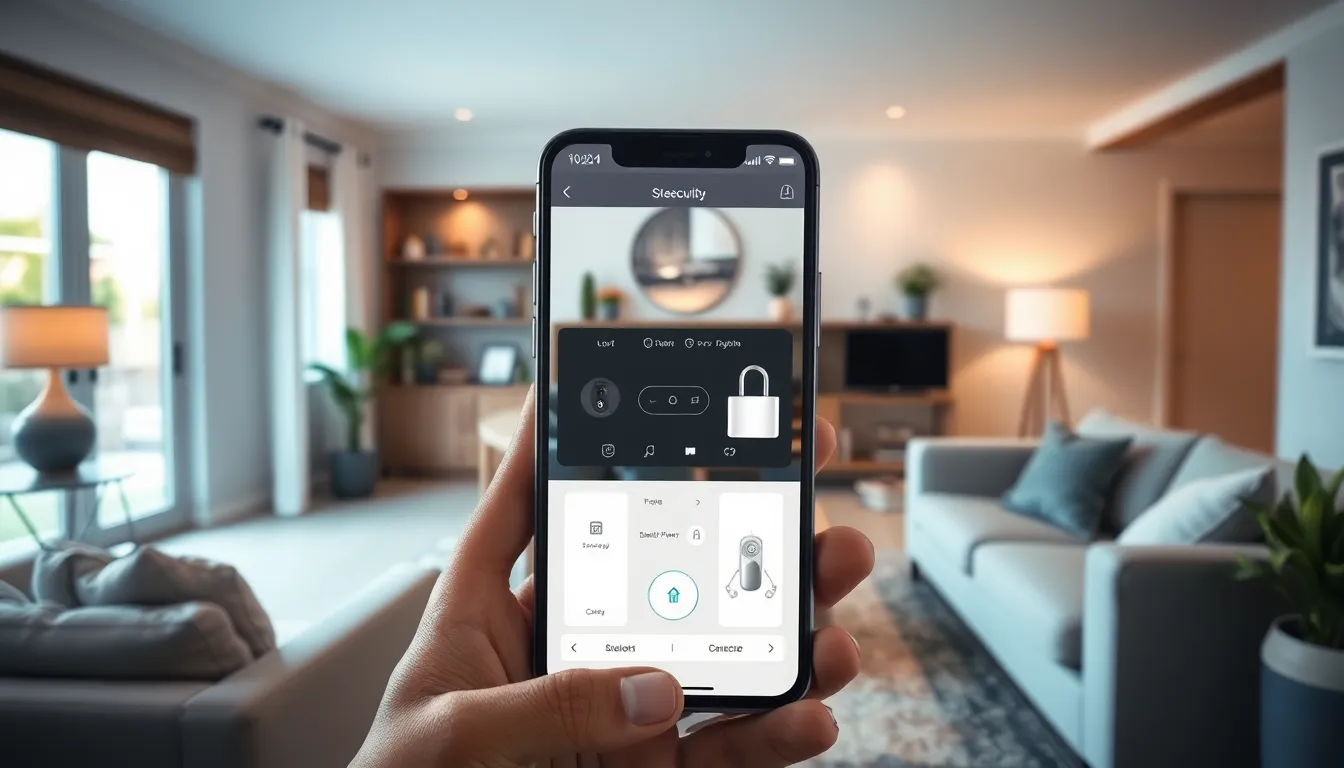In a world where even your toaster can be smarter than your average bear, it’s time to upgrade your home security game. Smart home security systems are the superheroes of modern living, swooping in to protect your castle while you binge-watch your favorite shows. Gone are the days of clunky alarms and neighborhood watch meetings that feel more like awkward family reunions.
Table of Contents
ToggleOverview of Smart Home Security Systems
Smart home security systems represent a significant advance in home protection technology. These systems integrate various devices, such as cameras, motion sensors, and alarms, offering real-time monitoring and alerts. Users access these features conveniently through smartphones or tablets, making adjustments easy from any location.
Integrated solutions enable seamless communication between devices, resulting in enhanced response times and improved security effectiveness. Analytics play a crucial role in these systems, providing insights into potential vulnerabilities and usage patterns.
Many systems allow for customization, enabling homeowners to tailor their security settings according to their preferences. Wireless technology facilitates this flexibility, eliminating the need for extensive wiring throughout the house.
Environmental sensors may accompany cameras and alarms, detecting smoke, carbon monoxide, or water leaks. This comprehensive approach provides an all-in-one safety solution for homeowners, streamlining various security measures into one cohesive system.
Cloud storage options enhance the functionality of smart security systems, enabling users to save surveillance footage for future reference. In contrast to traditional methods, these advanced systems offer continuous updates and improvements through software enhancements.
Due to advancements in artificial intelligence, some smart home security products feature facial recognition capabilities. This technology improves security by identifying familiar faces and alerting users of any unexpected visitors.
Affordability continues to improve with a growing number of manufacturers entering the market. Today’s consumers benefit from a wide range of options, ensuring there’s a solution available for any budget and need.
Key Features to Consider

When evaluating smart home security systems, several key features play a significant role in ensuring effective protection. Homeowners need to assess monitoring options, device integration, and user interface for the best experience.
Monitoring Options
Comprehensive monitoring options can enhance security. Homeowners often choose between professional monitoring services or self-monitoring through apps. Professional services typically offer 24/7 support and immediate emergency response. Self-monitoring provides flexibility, allowing users to receive alerts directly on smartphones. Remote access grants users the ability to check live feeds and recordings anytime. Advanced systems may include smart alerts with customizable settings for specific activities.
Integration with Other Devices
Integration with other devices is crucial for a seamless security experience. Many smart home security systems connect with smart locks, lights, and thermostats. This interconnectedness allows for automation of security protocols. For instance, a motion detection alert can trigger lights to turn on or the thermostat to adjust. Compatibility with popular platforms like Google Assistant or Amazon Alexa enhances functionality. Homeowners gain control through a single app, streamlining their entire smart home setup.
User Interface and Ease of Use
An intuitive user interface ensures easy navigation and operation. Systems with simple layouts enable users to access features quickly without confusion. Customization options enhance usability, allowing homeowners to personalize notifications and settings. Clear instructions during setup can minimize frustration and lead to quicker implementation. Systems with voice control or mobile access significantly improve user experience, offering convenience. Sufficient product documentation and customer support further contribute to effective usage.
Types of Smart Home Security Systems
Smart home security systems offer various options to fit different needs and preferences. Key distinctions in technology and installation methods exist.
Wired vs. Wireless Systems
Wired systems provide reliable connections through physical cables. They often require professional installation, ensuring stability and consistent performance. Wireless systems utilize Wi-Fi or cellular connections, allowing easy relocation of devices. Convenience plays a significant role, as these systems require minimal drilling. Wireless options may experience interference but offer flexibility. Homeowners can expand their setups without substantial upheaval, making wireless technology popular.
DIY vs. Professional Installation
DIY installations empower homeowners to customize their systems. Many modern devices come with straightforward setup instructions that support self-installation. Cost savings often accompany these choices, as professional services can add to expenses. Professional installation, however, guarantees expert setup and optimal device placement. Technicians address installation challenges and ensure systems function correctly. Those seeking peace of mind may prefer this approach, knowing that professionals handle the technical aspects. Selecting the right method depends on personal comfort levels and budget considerations.
Benefits of Smart Home Security Systems
Smart home security systems offer significant advantages that enhance protection for households. These benefits range from improved safety measures to greater convenience in monitoring.
Enhanced Safety and Security
Enhanced safety measures prevent break-ins and provide real-time alerts. Smart sensors detect unusual activity and trigger immediate notifications. Surveillance cameras capture live footage, allowing homeowners to monitor their property continuously. Deterrent capabilities increase as intruders are discouraged by visible security devices. Additionally, environmental sensors alert residents to potential hazards like smoke or carbon monoxide, ensuring comprehensive protection. Collectively, these features create a secure environment, promoting peace of mind for homeowners.
Remote Access and Control
Remote access and control provide homeowners with the capability to manage security systems from anywhere. Smartphone apps enable users to view live camera feeds and receive security alerts in real-time. Instant access allows for quick adjustments to settings, enhancing overall control of the system. Homeowners can also receive alerts when doors unlock or in cases of unexpected movement. Integration with smart home ecosystems further streamlines the management of security and other connected devices. This flexibility empowers residential users to maintain security effectively, even while away from home.
Popular Smart Home Security Systems on the Market
Numerous smart home security systems offer advanced features to enhance safety and convenience. Notable brands stand out for their effectiveness and reliability.
System Comparisons
When comparing systems, features and compatibility play significant roles. Ring and Arlo provide exceptional camera options, while Nest excels in smart integration with other Google products. ADT and SimpliSafe offer robust monitoring solutions, catering to different needs and budgets. Wireless systems, like Blink, allow quicker setup, while wired systems ensure more stable connections. Evaluating installation options reveals that DIY setups save costs, yet professional installations guarantee optimal placements. Trust in security systems comes from thoroughly researching features and understanding how they fit personal requirements.
Customer Reviews and Ratings
Customer feedback provides insights into real-world performance. Many users praise the ease of installation found in the August Smart Lock. Reviews highlight how effective the Ring Video Doorbell is in providing immediate alerts. Each product has unique strengths; therefore, assessing ratings on platforms like Amazon or Best Buy offers valuable perspectives. Reliability and customer service frequently emerge as essential factors in user satisfaction. High ratings reflect strong confidence in a brand, indicating products that consistently meet or exceed expectations.
Smart home security systems represent a significant advancement in protecting homes. By integrating various devices and offering real-time monitoring homeowners can achieve a level of security that traditional methods simply can’t match. The convenience of remote access and the ability to customize settings empower individuals to take control of their safety.
As technology continues to evolve affordability and accessibility improve making these systems more appealing to a wider audience. With numerous options available it’s crucial for homeowners to assess their specific needs and preferences. Investing in a smart home security system not only enhances safety but also provides peace of mind in an increasingly unpredictable world.




